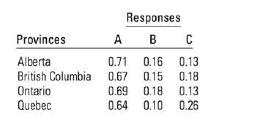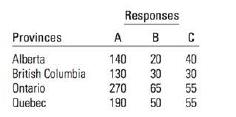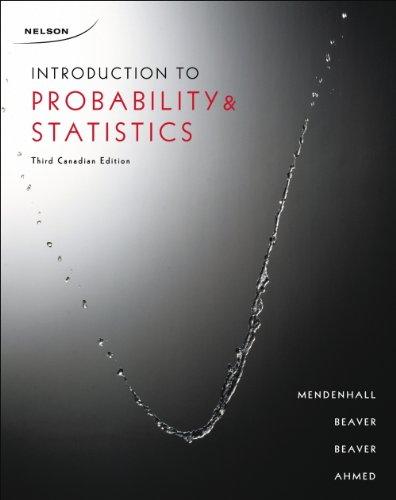Social/behavioural scientists are usually interested in knowing what are the important issues for Canadian singles when it
Question:
Social/behavioural scientists are usually interested in knowing what are the important issues for Canadian singles when it comes to dating. The print/digital media also has a keen interest in broadcasting these and other related issues. An example of this can be found in an online survey, http://www.theglobeandmail .com/life/the-love-poll/article1198058/. The first result of the survey was given on Friday, June 26, 2009, and is constantly updated on the website in real time. Suppose that in another online survey the following question was posed and re- spondents were given three response categories. Would financial status affect your decision as to whether or not you would be inter- ested in pursuing a relationship with someone? A: Matter a bit B: A huge matter C: Does not matter at all The results of the survey are summarised in the following table:

Generally speaking, online surveys are not scientific. This type of sampling plan is one form of a convenience sample-a sample that can be easily and simply obtained without random selection. We discussed this issue in Chapter 7, page 274, that all sampling plans used for making inferences must involve randomization. We need to re-emphasize here that non-random samples can be described but cannot be used for making inferences. For this statistical reason, a social scientist from Quebec finds these results dubi- ous and decided to conduct a scientific survey as opposed to the online survey. The results of her survey are displayed in the following table. The table lists the number of responses for each category in selected provinces.

In the following questions treat the percentages from the online survey as if they were the true population proportions and use the scientist's survey as your sample data.
a. Test whether there has been a change from the online percentages in Quebec. Use = 0.05.
b. State the null and alternative hypotheses to test whether the distribution of the response to the question "does not matter at all" agrees with the corresponding distribution from the online survey. State the hypotheses to be tested and use a = 0.01 to interpret your results.
c. Do the current data support that the proportions in category "A" have not changed compared to the online survey? Use a = 0.025.
d. Based on her results, the social scientist in Quebec believes that the proportions in category "C" are the same across provinces and she would like to test her beliefs. (i) State the null and alternative hypotheses. (ii) Compute the value of the test statistic. (iii) If you were to test this hypothesis using the chi-square statistic, how many degrees of freedom would the test statistic have? What is the rejection region? (iv) Test the hypotheses at a = 0.05, and write your conclusion.
e. Suppose you wish to analyze the relationship between responses to the question "Would financial status affect your decision as to whether or not you would be interested in pursuing a relationship with someone?" and the province of residence of the respondent. Write a short paragraph explaining your statistical conclusions and their practical implications for the researcher.
Step by Step Answer:

Introduction To Probability And Statistics
ISBN: 9780176509804
3rd Edition
Authors: William Mendenhall






